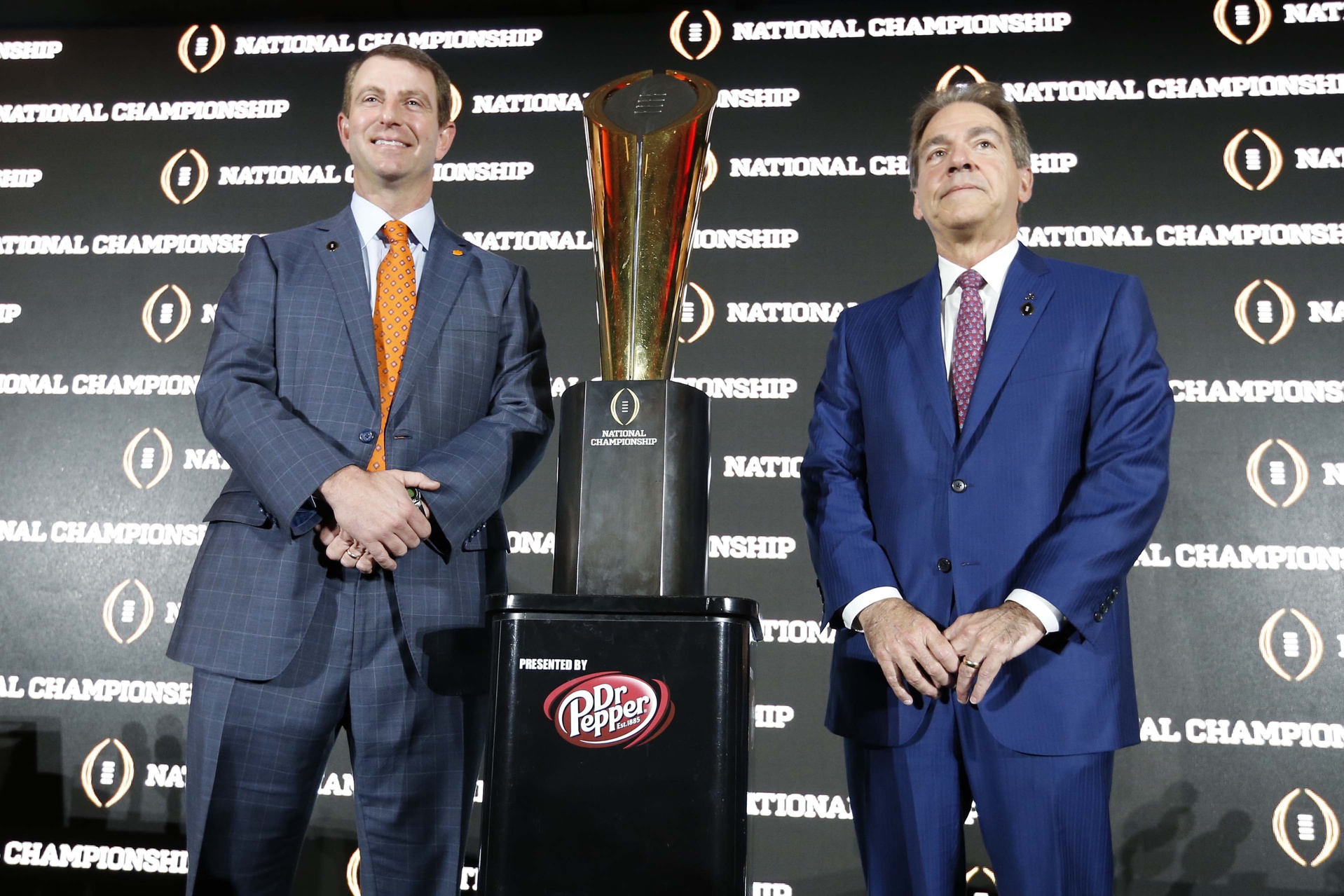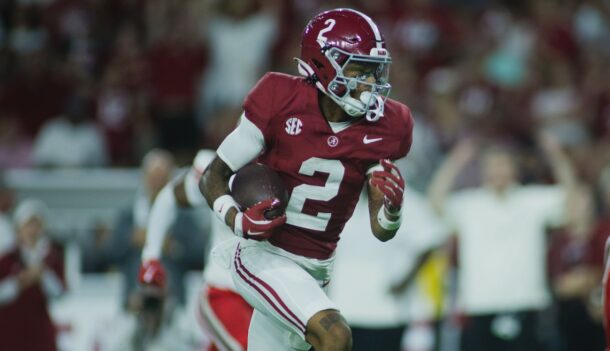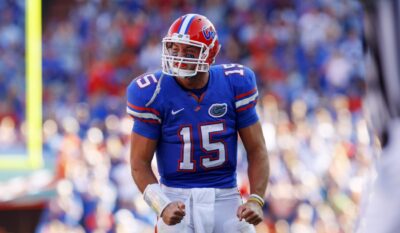
How Alabama and Clemson separated themselves from the rest of the college football world
If you’re bored with their success, I’m sorry. Maybe there’s a House Hunters marathon you can watch Monday night instead of Alabama and Clemson playing for the fourth consecutive year, the third time in the National Championship Game.
The rest of us will watch the programs who have represented 7 of the past 8 championship game participants and many will wonder how in the world they do it year in, year out. In an era that was supposed to be defined by the field of 4, it’s a field of 2 that separated itself from the pack.
Of course, it helps when you have Nick Saban and Dabo Swinney. No two coaches in the 21st century, I’d argue, have been better as recruiters, preparers and in-game decision-makers.
The question is why, or rather, how? How is it that both have mastered that trio of skills better than anyone in the sport by such a noticeable margin?
Let’s dig into that:
It starts with the defensive line
They say that defense travels. The best constant in the sport, even in this era of spread offenses, is the ability to stop the run. Alabama and Clemson have obviously been superior in that aspect.
Look at their numbers against the run the last 4 years:
[table “” not found /]That’s pretty telling. Those are all top-25 run defenses, and Clemson is in the top 3 for the first time during that stretch. Look at that defensive line and it’s not difficult to see why that’s the case. The suspended Dexter Lawrence is a massive part of that (literally), and having future first-round picks in Clelin Ferrell and Christian Wilkins is the obvious reason the Tigers are so good up front.
But remember how big of a deal that was last year when it was announced that Clemson would have all 3 back for 2018? Swinney’s ability to keep that group together instead of watching the likes of Wilkins and Ferrell leave for the NFL is one of the main reasons Clemson is playing Monday night. Getting an elite defensive mind like Brent Venables to stay as the Tigers’ coordinator for the past 7 seasons probably didn’t hurt, either.
And for Alabama, getting talented defensive linemen to wait their turn and star is one of Saban’s most underrated qualities as a head coach. I did an in-depth breakdown of the Alabama defensive line factory, which has yielded 7 NFL Draft picks in the past 3 years alone (that number will increase when Quinnen Williams, Raekwon Davis and Isaiah Buggs cash in this year).
It’s incredible to think that only 4 defensive linemen in the Saban era earned SEC All-Freshman honors. That’s out of 15 drafted defensive linemen. They aren’t leaving for greener pastures if they don’t play as true freshmen. Shoot, Saban had a U.S. Army All-American in Joshua Frazier who never started in 4 years at Alabama, yet he stayed and got drafted.
Saban and Swinney have staffs with a unique ability not only to recognize and develop defensive line talent, but also to retain it.
Yeah, it’s obviously recruiting and roster depth
Here’s something that won’t come as a surprise. Saban and Swinney have a nice little track record when it comes to the whole recruiting thing.
Here’s a breakdown of their classes since the start of the Playoff era (2014-18):
[table “” not found /]Clemson, while it isn’t quite the juggernaut that Alabama is when it comes to recruiting 5-star talents, rarely misses. Look at the 5-star talents that the Tigers signed during that stretch:
- WR Deon Cain
- OT Mitch Hyatt
- DL Christian Wilkins
- DT Dexter Lawrence
- WR Tee Higgins
- QB Hunter Johnson
- QB Trevor Lawrence
- DL Xavier Thomas
- DL KJ Henry
- OT Jackson Carman
- WR Derion Kendrick
What’s incredible is that with the exception of the 5 true freshmen on that list, there’s only 1 of those 5-star recruits who didn’t work out. It was Johnson, who only left because the nation’s No. 1 quarterback, Lawrence, came in and passed him up a year after he signed.
It wasn’t that long ago that we were wondering if Clemson’s rise to prominence was simply the byproduct of a once-in-a-generation player in Deshaun Watson. That question has faded in a hurry, and it’s because Swinney has hit on the big-time recruits he signed, and he still signed 5-star recruits on the defensive line like Thomas and Henry despite the fact that he got his entire all-world trio to return in 2018.
But you’d be surprised by the in-state recruiting
You would think that programs who recruit and develop so well would have their own states fenced off. That’s actually not the case. Not a single top-10 recruit from the state of South Carolina signed with Clemson in the 2019 cycle.
In Alabama, 3 of the top 4 in-state recruits elected not to pick the Crimson Tide. In 2018, only 1 of the top 15 recruits in state picked Saban’s program. Ironically enough, the No. 1 recruit from the state of Alabama was star Clemson receiver Justyn Ross.

Sure, that hasn’t always been the case. There have been years like 2016 and 2017 when Alabama did land the top in-state recruits. The same is true for Clemson, which signed the top 2 recruits from South Carolina back in 2016.
But what this speaks to is their ability to recruit nationally. Clemson is a national brand. That’s why it signed recruits from 14 states in 2019. Alabama covered 11 states with its 2019 class.
It’s not like both schools are lacking in-state talent and they go national because that’s where the blue-chippers are (though that would make their dominance even more impressive to not have that recruiting background). It’s that they can go to California and sign someone like Najee Harris, or they can go to Georgia and sign the No. 1 recruit in the country in Lawrence.
If both Alabama and Clemson did the cliché, new-coach-on-the-job line of saying their goal was to “rope off the state,” they simply wouldn’t be where they are right now.
They were willing to adapt offensively
For Clemson, it was Chad Morris. For Alabama, it was Lane Kiffin. Both of those coaches were responsible for bringing their respective offenses into the 21st century. Having players who could spread teams out and operate as mobile but still pass-first quarterbacks was huge. Both Morris and Kiffin left their respective identities on those programs for years to come.
That couldn’t have been easy for someone like Swinney, an offensive-minded coach, to put his faith in someone who was coaching high school football 2 years before coming to Clemson. And likewise, that couldn’t have been easy for an accomplished coach like Saban, to turn to a high-profile coach like Kiffin, who was young enough to be his son.
But no longer is Alabama just the team that has a trio of 5-star running backs who moves the chains while their quarterback is labeled a “game manager” (fair or not). Even though Saban shuffles through coordinators like Brita filters, he always hires someone who’s willing run Kiffin’s system, which might not feature the running backs quite as much as Saban wants, but it made Alabama a multi-dimensional offensive force.
And as for Clemson, the Tigers are now the team that’s recruiting NFL talents at quarterbacks left and right. They suddenly have so much talent in their quarterback room that just had their 2017 Playoff starter transfer — from a team that was No. 1 entering the postseason — as well as the aforementioned 5-star Johnson.
The modernization all started somewhere …
Both found their transcendent quarterbacks
Morris was credited with signing Watson, and Kiffin was credited with signing Tua Tagovailoa (after switching off once-committed Jake Fromm). Neither was the top quarterback recruit in their respective class, yet both Morris and Kiffin locked in on them because they were perfect fits in their systems.
The irony is that both Morris and Kiffin left for head coaching gigs before Watson and Tagovailoa became stars. Morris got half a season with Watson as his starter and Kiffin was on a beach in Boca Raton when Tagovailoa stepped foot at Alabama.

If you try and tell the college football story over the past 4 years, Watson and Tagovailoa are 2 of the main characters. This will mark the fourth year in a row that one of them will play in a title game.
The word “transcendent” is appropriate with them not only because they were and are incredibly successful players. It’s because of what they’re doing for the generation to follow. Lawrence, a fellow Georgia native like Watson, admitted that a big reason he picked Clemson was because of watching Watson’s path to success. Now, of course, Lawrence is already a star in the sport.
And while there’s no guarantee that Tagovailoa’s successor will be a star, look at what Alabama just did in the 2019 class. Tagovailoa’s younger brother, Taulia, signed with the Crimson Tide. He committed to the program 2 weeks after Bear Bryant’s great-grandson, Paul Tyson, gave his pledge to Alabama. Both are 4-star recruits. Extremely rare it is that 2 blue-chip quarterbacks commit to the same program.
But who wouldn’t want to become the next Tagovailoa or Watson? It makes sense that these programs are suddenly overflowing with talent at the most important position, which you couldn’t have said 5 or 6 years ago.
One simple, final thought
I could go on for hours about recruiting exploits, in-game decision making, annual revenue (though Clemson isn’t on Alabama’s level with that) and everything in between to explain why Alabama and Clemson are heads and shoulders above the competition.
OK, I basically did that already.
I once asked a former Alabama player what it was that makes the Crimson Tide machine go. As in, how has Saban achieved G.O.A.T. status. The answer he gave me didn’t have anything to do with game-planning or 5-star recruits. It was a message that Saban preaches and executes with his team as well as anyone.
“Doing the right thing is often uncomfortable. Not everyone is willing to be uncomfortable in order to succeed.”
We’ve seen teams across the country sign elite recruiting classes, and we’ve seen some go to national championships. But getting a group of extremely talented 18-22 year-old kids to truly buy into that concept is a different ballgame. It’s a common denominator. It’s how a machine becomes a machine and not just a flash-in-the-pan.
These past 4 years have done more than enough to prove that. Who knows how long this torrid pace will continue. For all we know, we could be in for a 10-year war that’ll be unlike anything we’ve ever seen in college football. In many ways, this stretch already is unprecedented, at least in the modern era.
There might not be one secret ingredient to the success of Alabama and Clemson, but whatever it is, there’s one thing that we’ll get constant reminders of for the foreseeable future.
It’s Alabama and Clemson’s world, and we’re all just living in it.
Connor O'Gara is the senior national columnist for Saturday Down South. He's a member of the Football Writers Association of America. After spending his entire life living in B1G country, he moved to the South in 2015.







